Therassia
the younger daughter of King Theras
the younger daughter of King Theras
The island is oblong in shape, with an 8 km diameter in length and a 2.5 km diameter in breadth. Its total surface is 9.3 square kilometers. It shares the same morphology and similar architecture with Thera as to its houses and churches.
According to Greek mythology, the island was named after the younger daughter of King Theras, Therassia, to whom he offered the island to build a majestic palace in the area of Kavos-Korfos.
It is believed that it was formed during the great volcanic eruption of 1600 BC. The famous Greek historian Plinios mentions that in 237 BC it was detached from Santorini after an earthquake.
Ptolemy mentions that Therassia was a city where important prehistoric relics of the Cycladic civilization were found and that throughout history it followed the fate of Thera as its “appendage”. In 1397, the Duke of Naxos Francesco I Crispo is believed to have offered Therassia to his son Marco I Crispo, along with the island of Ios.
In 1866, the mines in Therassia and Thera were in full swing due to exportation of Theran land to Egypt for the construction of the Suez Canal. Some workers in the N. Nomikos-Sigouras Alafouzos mine discovered an ancient building, several pots and a human skeleton.
Doctor and member of the Parliament Nicholaos Nomikos together with Alafouzos made sure of the building’s excavation and relative articles were published in magazines and newspapers. Due to the volcano’s activity during that period, several scientists from all around the world had arrived in the area, among them French volcanologist Fouque who in 1867 excavated in Therassia and studied the ruins of buildings and discoveries –fruits, stone vessels (bowls), utensils and tools, an arrow made of obsidian.
The settlement of Therassia is dated in the Late Bronze Age and these discoveries triggered excavations in Akrotiri and other places of Thera. In fact, in 1867 Fouque himself begun excavations in the region around Akrotiri to find same pieces of vessels as those in Therassia, knives, arrows and two gold rings from a necklace.
Different ways to get to Therassia from any location
![]() Athinios Port (Santorini) to Therassia 11 km
Athinios Port (Santorini) to Therassia 11 km
![]() Ammoudi bay (Santorini) to Therassia 4 km
Ammoudi bay (Santorini) to Therassia 4 km
